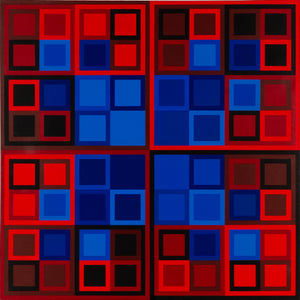Blue Chinese Night
Reiner Kallhardt
Artwork Details
Artwork Description
Title: Blue Chinese Night
Artist: Reiner Kallhardt
Date: 2003
Medium: Oil on canvas
Dimensions: 35.4 x 35.4 in (90 x 90 cm)
Artwork Identification:
Blue Chinese Night is a striking geometric composition by Reiner Kallhardt, constructed from a meticulously arranged grid of chromatic square forms. The surface is dominated by a rhythm of blue and red squares nested within one another, distributed symmetrically across four quadrants. This visual equilibrium results in a powerful optical vibration, evoking a meditative yet dynamic spatial rhythm.
Artistic Style and Influences:
Kallhardt’s practice is situated within the Op Art and Geometric Abstraction traditions, drawing influence from artists such as Josef Albers and Victor Vasarely. In this work, his precise use of contrasting primary colors—deep crimson, ultramarine, cobalt, and black—produces a kinetic energy and perceptual depth. The repetition and chromatic variation of the square motif explore the relationship between color, structure, and visual experience.
Historical Context:
Executed in 2003, Blue Chinese Night reflects early 21st-century revisitations of modernist abstraction, inflected with a contemporary sensibility for digital aesthetics and spatial harmony. The Title: hints at a poetic or metaphorical connection to Chinese visual culture or nocturnal urbanity, although Kallhardt renders it purely through color rather than figuration, inviting open interpretation.
Provenance:
Provenance documentation can be provided upon contact.
Condition and Conservation:
The painting is in very good condition. The canvas is taut, and the paint surface remains clean, with colors retaining their original saturation and intensity. No signs of flaking, discoloration, or restoration are evident.
Artistic Significance:
Blue Chinese Night exemplifies Kallhardt’s command of color theory and formal repetition. Its bold visual syntax offers an immersive encounter with color as both a perceptual and emotional agent. The work stands as a contemporary continuation of optical abstraction, affirming Kallhardt’s place in the ongoing dialogue between geometry, perception, and aesthetic precision.


